A Complete-ish Guide to Eastern Warblers
Warblers, animism, more warblers, indigestion, molting madness, and more
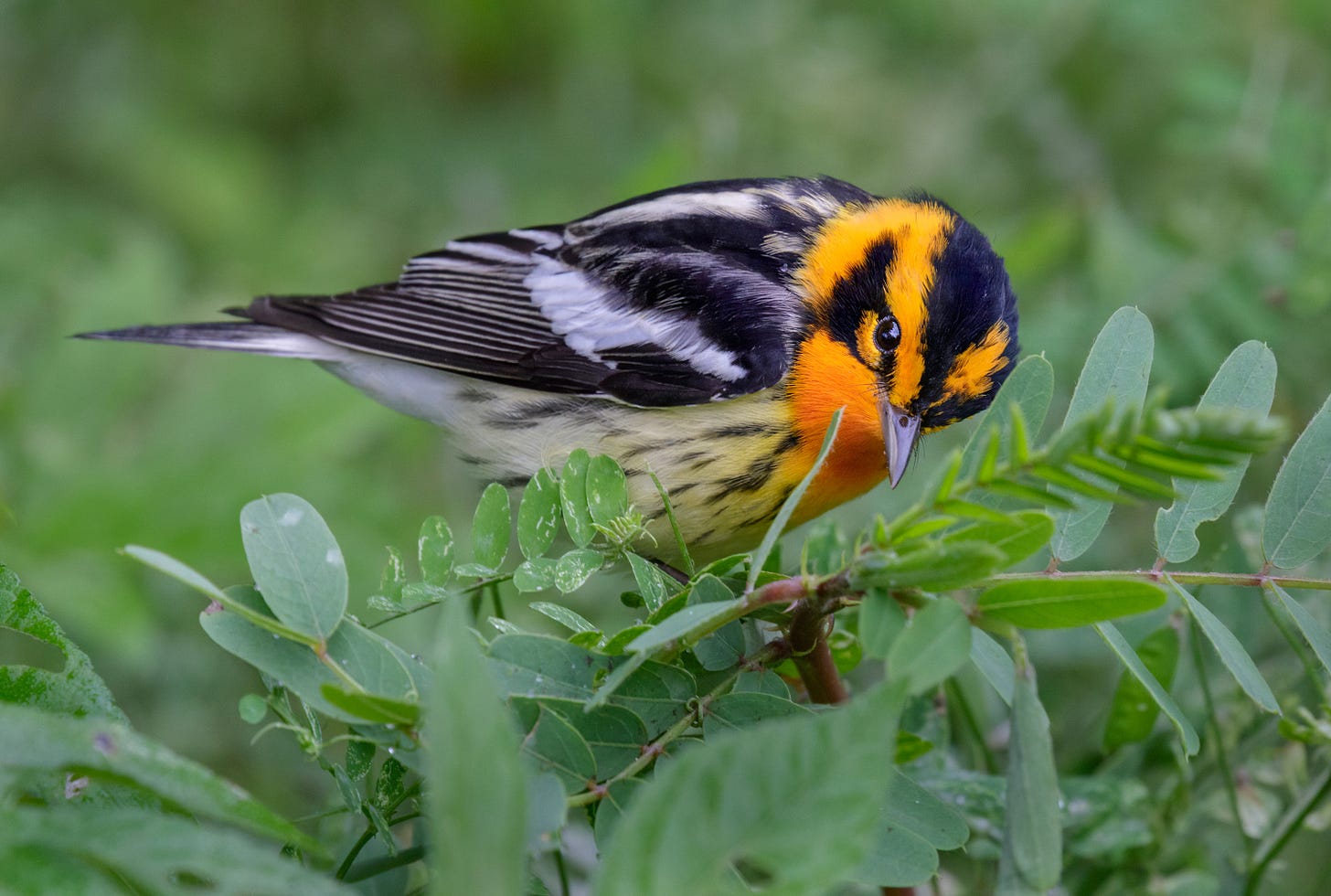
Honorable Warblerheads,
We’ve written more than a time or two about the tiny, beautiful, migrating songbirds who move through NYC during spring and fall. Spanish speakers call them little queens. Awestruck new birdwatchers: Little gods.
But no more poetry. No more prizes. No more threats. We chucked the carrot and ate the stick. (You read right. We’re warbler crazy, man.) Chomp-crunch-gulp-grimace.
In lieu of this week’s micro-season, we present: A Complete-ish Guide to Eastern Warblers. Whether you have a quick glance or make flashcards or completely ignore it, know this: IRL noticing a warbler you’d only seen on page changes you.
Molt on,
Bird Club Studio
A Complete-ish Guide to Eastern Warblers
Below are 26 warbler species in their spring then, if applicable, fall plumage. (Left [or top] then right [or bottom], respectively.) These are what might be called the most common warblers found east of the Rockies. The less common eastern species—those never recorded in McGolrick Park—are listed at guide’s end. So too are west-of-the-Rockies warblers, who newly afflicted warbler sickos will yearn to know.
Nota bene: Objects in the below images may appear clearer than they are IRL. Don’t fret. Join us this month, Tuesday and Friday mornings starting at 6:30am, when birds are most active. Experience solidifies learning.
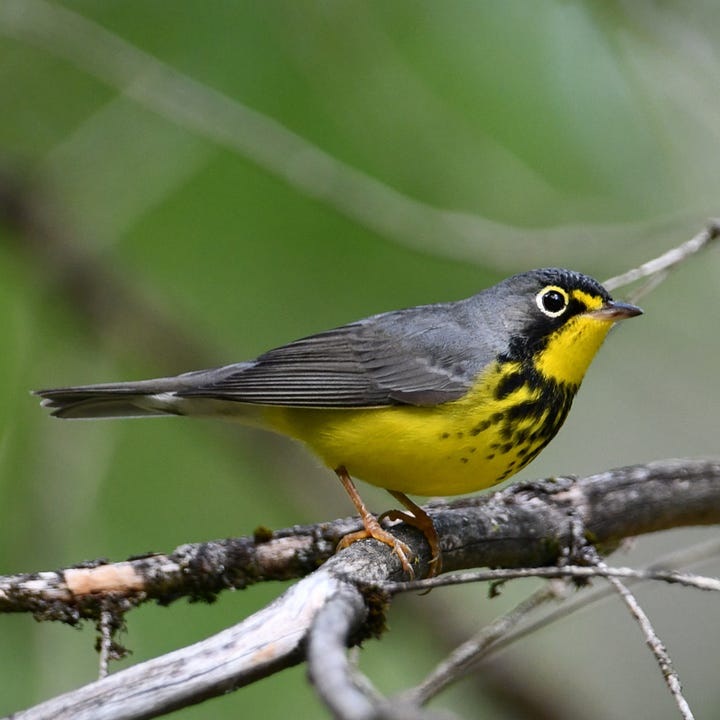

Canada Warbler • Breeding Canada males’ chunky necklaces/cute spectacles fade in fall, but remain perceptible. The gray winter coats over yellow bottoms stay. 🔑🍂: Blue-gray tops & yellow bottoms. Remnant necklace and spectacles.


Mourning Warbler • The Mourning Warbler’s executioner hood looks a little less drippy in fall. All gray head, including throat, over a yellow-ish bod on our classically shy, skulking warbler. 🔑🍂: Full gray hood meets yellow-olive bod. Shy and low.


Nashville Warbler • Spring’s Nashvilles are perfect white eye-rings over gray cheeks + yellow throats/bodies + olive wings. In fall, the eye-rings remain bright—the rest washes out. 🔑🍂: Bright white eye-ring over unmarked gray head, soft yellow bottom.


Magnolia Warbler • Fall Mags have pretty eye-rings too, but notice their high-contrast wing bars and black side-stripes over yellow. They also rock green capes, though those aren’t always seen. 🔑🍂: Black side stripes over yellow sides. Wing-bars.


Prairie Warbler • It’s the face that fades for fall. You’re still looking for a well-defined under-eye baggie; plus two black side stripes over yellow. (Notice how the lack of wing-bars and broken eye-ring distinguish them from fall Magnolia. 🔑🍂: Eye-baggie & black side stripes over yellow.


Common Yellowthroat • Spring masks fade some or all in fall, making for a gray-tan cheeked/headed/backed over still yellow throat and tummy’d bird. As always, check low for these skulking hotties. 🔑🍂: Frowny yellow throats + drab tan-grays. Look low.


Northern Parula • Spring Parulas’ diagnostic orange/black necklaces fade in fall. So too do their blue-grays and black eye marks. But the yellow throat/chest meeting white lowers stay! So too do their tiny bods. (They’re our smallest eastern warbler.) 🔑🍂: Blue-grays & yellows & whites. Tiny.


Pine Warbler • Egg yolk tops fade in fall, leaving yellow-hinted grays. Look especially for remaining evidence of spring spectacles, including a just broken eye-ring. 🔑🍂: Yellow-kissed gray + broken eye-ring.
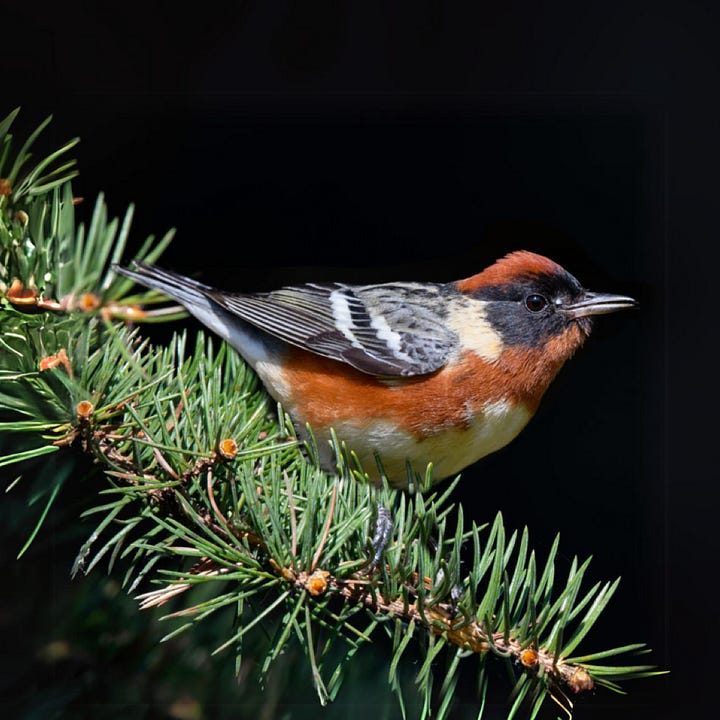

Bay-breasted Warbler • Fall Bay-breasted Warblers have dingy yellow heads, wing-bars and DARK legs. They occasionally rock remnants of their namesake bay sides. 🔑🍂: Dingy yellow fronts + white bods, wing-bars, DARK legs. Sometimes: bay side stripes over off-white.


Blackpoll Warbler • Fall Blackpolls look exactly like above Bay-breasts except they never have brown side-stripes AND, crucially, they have YELLOW legs. 🔑🍂: Dingy yellow fronts + white bods, wing-bars, YELLOW legs.


Black-throated Green Warbler • Olive top + yellow luchador mask over namesake black throat that goes white in fall. White bods. Note high contrast black and white wings and side stripes. 🔑🍂: Yellow-green top/luchador mask over white/black.


Blackburnian Warbler • Their once neon/black luchador masks fade to yellow-orange/gray in fall. Besides yellow-orange (not yellow-green) fronts, look for thin gray side-stripes. 🔑🍂: Yellow-orange top/luchador mask over white/grays.
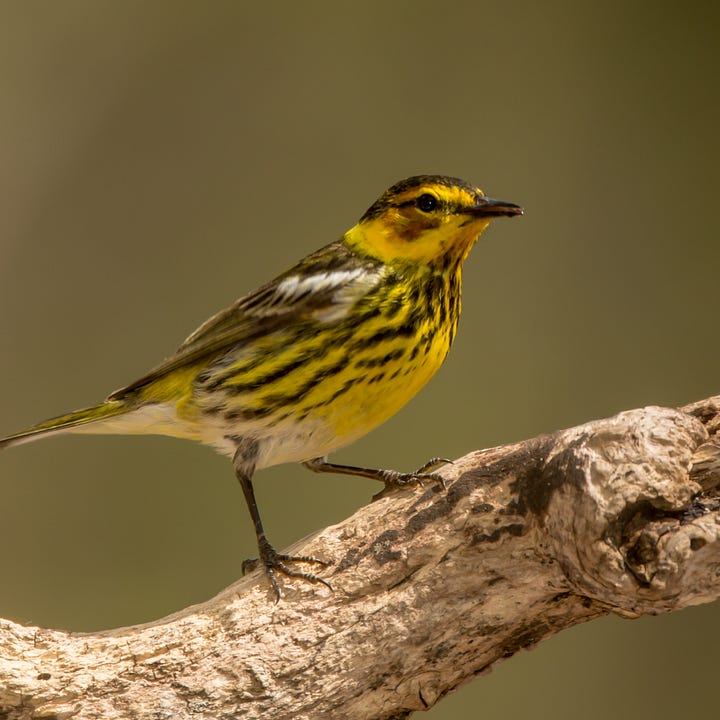

Cape May Warbler • While most warblers rock side-stripes, Cape Mays do full striped frontals. In fall, check for remnant hints of those super sweet spring face masks + mops. 🔑🍂: Heavily striped + gray-yellow-ish fronts. Remnant masks.


Chestnut-sided Warbler • The baddest of all costume changers. Spring Mike Tyson face tattoo? Laser’d off. Yellow yarmulka? Gone green. There is simply no other American bird quite so gray/mossy topped. 🔑🍂: All moss top. Gray.
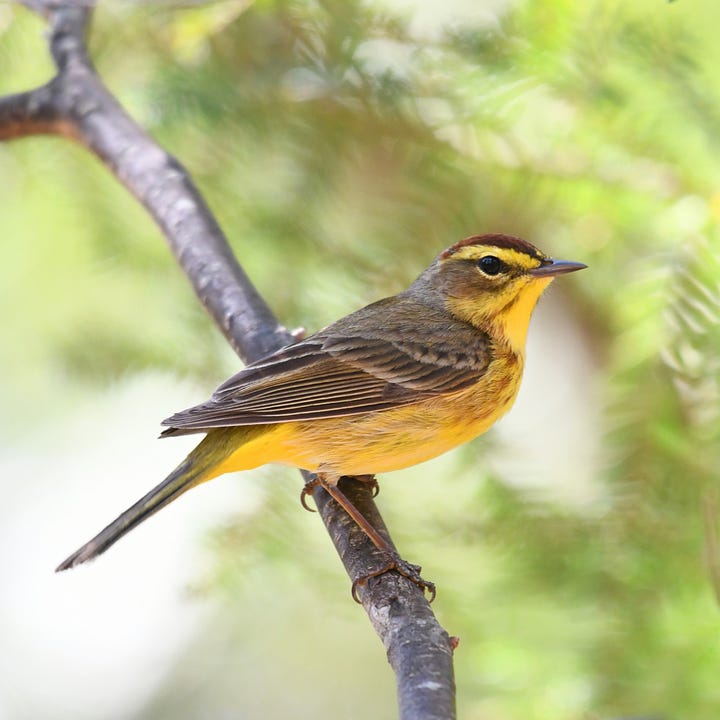

Palm Warbler • Palms drop springtime gold and burgundy for shades of gray + a touch of tuchus yellow. Subtle beauty alert! Palms have a fantastic, tail-borne tell—theirs are almost always pumping! 🔑🍂: Tail-pumping gray/yellow. Check lawns.


Black-throated Blue Warbler • Spring’s aptly named black-throated blue trade their namesake parts for fall’s middle and light grays. Besides that kinda angry looking brow, be sure to notice the lil’ white pocket square on its wing. (See it, picture right?) Fancy little floof. 🔑🍂: Grayish angry bird with a white pocket square.


Yellow-rumped Warbler • Rumpers go gray in fall, with varying degrees of side-stripes bookended by yellow ‘pits. Look for gray-white, top-bottom contrasting birds, who retain namesake yellow rectangles on their lower backs. 🔑🍂: Gray-white birds with masks, side-stripes, yellow ‘pits … butter butts.


American Redstart • Redstarts swap springtime black + orange for autumn’s unstriped gray + yellow. Hard to capture in image is redstarts’ most important feature: their distinctive, long, often fanned, tail. 🔑🍂: Grayish birds accented with yellow. Long, often fanned tails. Butterfly moves.


Black-and-white Warbler • Black-and-whites, with their distinctive zebra stripes + tree creeping moves, are an easy to identify/love warbler. Nice too is that their fall plumages aren’t all that different from spring’s—just less striping on the face and throat. 🔑🍂: Striped creeper.


Ovenbird • Ovenbirds don’t do variable plumages. Just know that one orange mohawk’d, darkly streaked, tan backed, chicken-walking look, and you’re good to go. 🔑🍂: Low-level chicken walker.
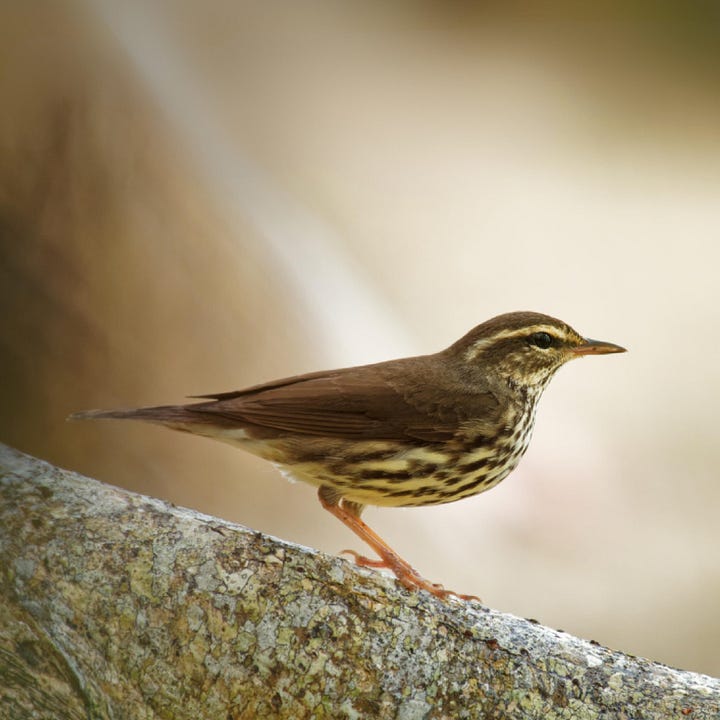

Northern Waterthrush • Like Ovenbirds, Waterthrushes don’t fit the classic perching warbler template AND they don’t change for fall. Find ‘em low, vigorously pumping their tails. Northerns will need to be distinguished from Louisiana Waterthrushes, who are identical save Northerns’ neck stripes and more off-white, yellow-ish washes. 🔑🍂: Low, all-striped tail pumper.


Blue-winged Warbler • The only bright yellow warbler with cat-eye makeup and blue-gray wings who, mercifully, doesn’t change much spring ←→ fall. 🔑🍂: Cat-eyed yellow bird with blue-gray wings.


Hooded Warbler • In fall, look for faded, face-circling balaclavas—some still black, some olive. Another good tell, hard to capture in image, is the Hooded’s tail, which quickly fans out white feathers when the bird hunts low. 🔑🍂: Bright yellow, olive, remnant hood-top, white tail flicks. Low.

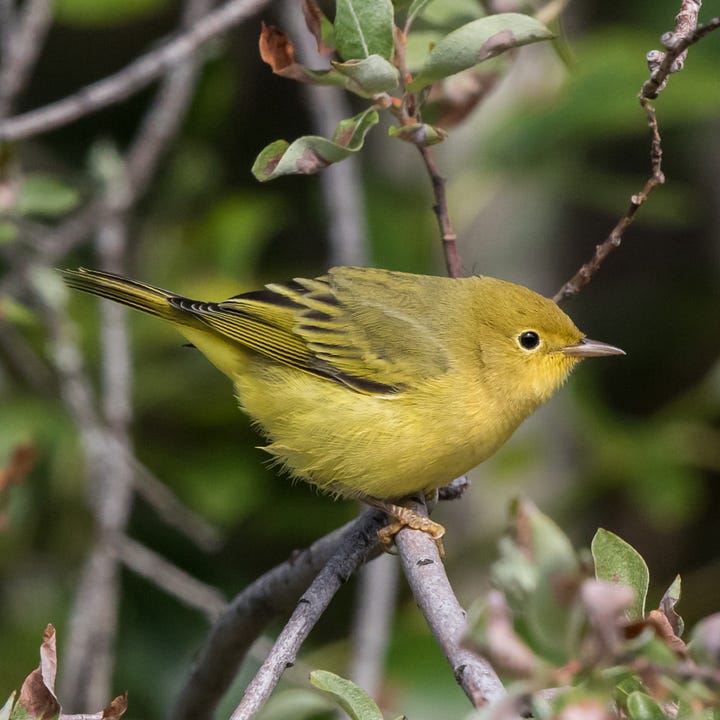
Yellow Warbler • Yellow Warblers, so striking in spring, go gray → soft yellow in fall. Look for unmarked birds that can really be anywhere on the gray-yellow spectrum. 🔑🍂: Yellow-grays. Unbroken eye-rings.


Wilson’s Warbler • Willys’ fall looks are easy to confuse with Yellows’ & Hoodeds’. Wilson’s are a bit more olive overall. Pray for a bit of leftover spring toupée. 🔑🍂: Yellow-olive-gray. Unbroken eye-rings. More gray on tail’s underside.


Tennessee Warbler • Spring’s moss-winged, white-browed males go yellow-gray in fall, but retain that signature, lengthy brow. Use this to distinguish its from the above yellow-gray birds. 🔑🍂: Yellow-olive-gray. Long eyebrow.
Other Eastern warblers: Worm-eating Warbler • Yellow-throated Warbler • Kentucky Warbler • Prothonotary Warbler • Orange-crowned Warbler • Kirtland’s Warbler
Western warblers: Hermit Warbler • Black-throated Gray Warbler • Townsend’s Warbler • Painted Redstart • Golden-cheeked Warbler • MacGillivray’s Warbler • Lucy’s Warbler • Virginia’s Warbler • Grace’s Warbler • Olive Warbler • Red-faced Warbler
Want more? Check out these other migrating bird types whom we expect to hang with this fall: Thrushes • Tanagers • Vireos • Vultures




